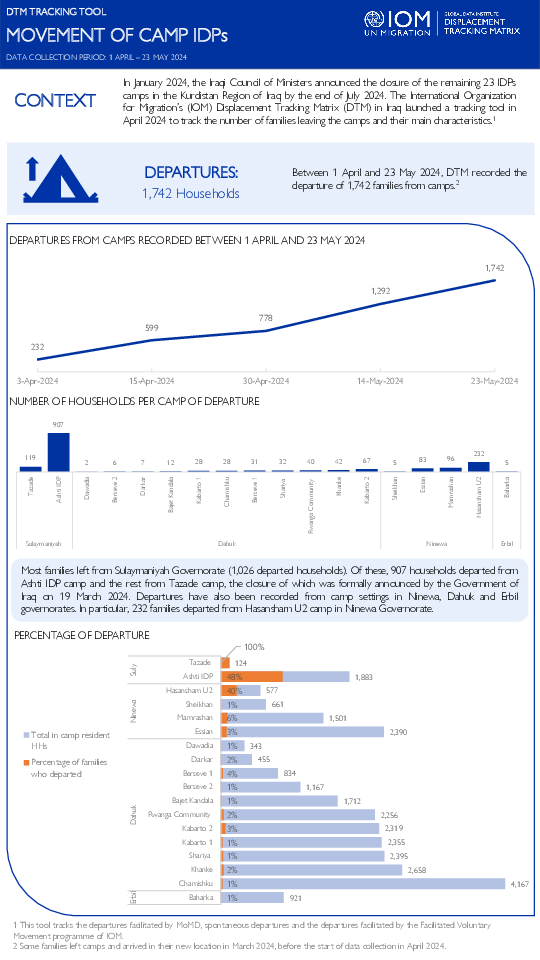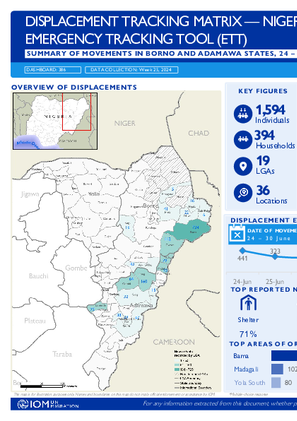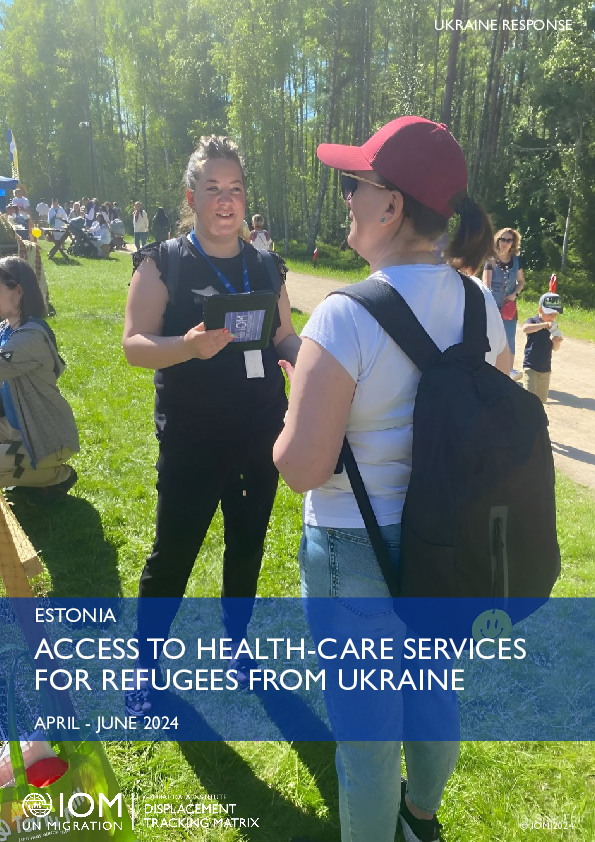-
Countries
-
Data and Analysis
-
Special Focus
-
Crisis Responses
Error message
The submitted value field_published_date_value in the Sort by element is not allowed.

Contact
IraqDTM@iom.int
Language
English
Location
Iraq
Period Covered
Apr 01 2024
May 23 2024
Activity
- Mobility Tracking
- Event Tracking
In January 2024, the Iraqi Council of Ministers announced the closure of the remaining 23 IDPs camps in the Kurdistan Region of Iraq by the end of July 2024. The International Organization for Migration’s (IOM) Displacement Tracking Matrix (DTM) in Iraq launched a tracking tool in April 2024 to track the number of families leaving the camps and their main characteristics.

Contact
IraqDTM@iom.int
Language
English
Location
Iraq
Period Covered
Nov 01 2022
Nov 30 2022
Activity
- Survey
- Displacement Solutions
This factsheet on Sinjar District is an extension of the original pilot project in Ninewa Governorate aimed at assessing progress towards durable solutions to displacement for internally displaced persons (IDPs) and returnees in the governorates with the largest shares of displaced populations in Iraq. The goal is to understand where IDPs and returnees in Sinjar District stand five years after the end of the 2014–2017 crisis and in which aspects they are still struggling. In this respect, this project contributes to a broader discussion and Action Agenda around measuring progress towards solutions and determining the end of displacement. The assessment measured progress along five criteria stemmed from the Inter-Agency Standing Committee (IASC) Framework for Durable Solutions: 1) safety and security; 2) adequate standards of living; 3) access to livelihoods; 4) restoration of housing, land and property (HLP) and compensation and 5) personal documentation and participation.
Data collection for this factsheet took place in November 2022, across 3 sub-districts and 17 locations in the district of Sinjar. The focus of the study was on both IDPs and returnees within the district, including IDPs who are displaced within the district itself. Data were collected through IOM’s Rapid Assessment and Response Teams (RARTs), composed of over 73 staff members (40% of enumerators are female). They collected data through structured face-to-face interviews with a sample size of 310 IDP and 336 returnee households in Sinjar district.

Contact
DTM Pakistan, DTMPakistan@iom.int
Language
English
Location
Pakistan
Period Covered
Jun 16 2024
Jun 30 2024
Activity
- Flow Monitoring
The International Organization for Migration (IOM) in Pakistan collects data on the outflows of Afghans at the Torkham (Khyber Pakhtunkhwa), Badini, Bahramcha and Chaman (Balochistan) border crossing points (BCPs) to better understand the movements of Afghans returning to Afghanistan. The data presented below is harmonised with those from the United Nations High Commissioner for Refugees (UNHCR), who also cover Ghulam Khan (Khyber Pakhtunkhwa).
On 26 September 2023, the Ministry of Interior in Pakistan announced its decision to enact its “Illegal Foreigners’ Repatriation Plan (IFRP)”. Between 16 and 30 June 2024, 15,149 Afghan nationals returned to Afghanistan, including 12,434 through the Torkham BCP, 2,580 through the Chaman BCP, 135 through the Ghulam Khan BCP, while no Afghan nationals returned through the Badini and Bahramcha BCPs. In addition, border authorities deported 342 individuals due to a lack of valid documentation. Since 1 January 2024, IOM identified 156,580 returns at the four BCPs.

Contact
DTM Ethiopia, DTMEthiopia@iom.int
Language
English
Location
Ethiopia
Period Covered
May 01 2024
May 31 2024
Activity
- Flow Monitoring
In May 2024, a total of 36,075 movements were observed across the six flow monitoring points (FMPs) in Ethiopia. This represents a 0.5% decrease in daily average movements in comparison with April 2024 when an average of 1,170 movements per day were observed.
The ratio between outgoing movements (64.7% or 23,346 individuals) during May and incoming movements (35.3% or 12,729 individuals) remained the same compared to April movements. Historically, recorded outflows have been higher than inflows as seen in the figure below. However, in May and June 2023, due to the outbreak of the Sudan crisis, inflows exceeded outflows.

Contact
iomnigeriadtm@iom.int
Language
English
Location
Nigeria
Period Covered
Jun 24 2024
Jun 30 2024
Activity
- Mobility Tracking
- Event Tracking
Between 24 and 30 June 2024, a total of 1,594 new arrivals were recorded at locations in Adamawa and Borno states. The new arrivals were recorded at locations in Askira/Uba, Bama, Dikwa, Gwoza, Kaga, Kala Balge, Mafa, Monguno and Ngala Local Government Areas (LGAs) of the most conflict-affected Borno State, and in Fufore, Gombi, Hong, Lamurde, Madagali, Maiha, Michika, Song, Yola North and Yola South LGAs of Adamawa State.
ETT assessments identified the following movement triggers: military operations (548 individuals or 34%), poor living conditions (377 individuals or 24%), improved security (315 individuals or 20%), seasonal farming (175 individuals or 11%), family re-unification (90 individuals or 6%), fear of attack (42 individuals or 2%), camp closure (31 individuals or 2%) and access to humanitarian support (16 individuals or 1%).

Contact
DTM Yemen, iomyemendtm@iom.int
Language
English
Location
Yemen
Period Covered
Jun 30 2024
Jul 06 2024
Activity
- Mobility Tracking
- Event Tracking
IOM Yemen DTM’s Rapid Displacement Tracking (RDT) tool collects data on estimated numbers of households forced to flee on a daily basis from their locations of origin or displacement, allowing for regular reporting of new displacements in terms of estimated numbers, geography, and needs. It also tracks returnees who returned to their location of origin.
From 1 January to 6 July 2024, IOM Yemen DTM tracked 1,688 households (HH) (10,128 Individuals) who experienced displacement at least once.
Between 30 June and 6 July 2024, IOM Yemen DTM tracked 44 households (264 individuals) displaced at least once. The majority of people moved into/within the following governorates and districts:
- Ma’rib (31 HHs) – Al Abdiyah (15 HHs), Ma’rib City (8 HHs), Ma’rib (8 HHs) districts. Most displacements in the governorate originated from Ma’rib and Al Jawf.
- Ta’iz (7 HHs) – Jabal Habashi (5 HHs), Al Maafer (2 HHs) districts. Most displacements in the governorate originated from Ta’iz and Al Hodeidah.
- Al Hodeidah (4 HHs) – Hays (4 HHs) district. Most displacements in the governorate originated from Al Hodeidah and Ta’iz.
The majority of people moved from the following governorates and districts:
- Ma’rib (17 HHs) – Al Abdiyah (15 HHs), Bidbadah (1 HH), Harib (1 HH) districts.
- Ta’iz (8 HHs) – Maqbanah (5 HHs), Al Mudhaffar (1 HH), Jabal Habashi (1 HH) district.
- Al Hodeidah (7 HH) – Al Jarrahi (4 HHs), Al Qanawis (1 HH), Al Hawak (1 HH) districts.
IOM identified 22 additional households displaced in the previous reporting period, which covered 23 - 29 June 2024, in the governorates of Al Hodeidah (12 HHs), and Ma’rib (10 HHs). These figures have been added to the cumulative displacement total recorded since the beginning of the year.
Contact
DTM Yemen, iomyemendtm@iom.int
Location
Yemen
Activity
- Mobility Tracking
- Event Tracking
Period Covered
Jun 30 2024 -Jul 06 2024
From 1 January to 6 July 2024, IOM Yemen DTM tracked 1,688 households (HH) (10,128 Individuals) who experienced displacement at least once.
Between 30 June and 6 July 2024, IOM Yemen DTM tracked 44 households (264 individuals) displaced at least once. The majority of people moved into/within the following governorates and districts:
- Ma’rib (31 HHs) – Al Abdiyah (15 HHs), Ma’rib City (8 HHs), Ma’rib (8 HHs) districts. Most displacements in the governorate originated from Ma’rib and Al Jawf.
- Ta’iz (7 HHs) – Jabal Habashi (5 HHs), Al Maafer (2 HHs) districts. Most displacements in the governorate originated from Ta’iz and Al Hodeidah.
- Al Hodeidah (4 HHs) – Hays (4 HHs) district. Most displacements in the governorate originated from Al Hodeidah and Ta’iz.
The majority of people moved from the following governorates and districts:
- Ma’rib (17 HHs) – Al Abdiyah (15 HHs), Bidbadah (1 HH), Harib (1 HH) districts.
- Ta’iz (8 HHs) – Maqbanah (5 HHs), Al Mudhaffar (1 HH), Jabal Habashi (1 HH) district.
- Al Hodeidah (7 HH) – Al Jarrahi (4 HHs), Al Qanawis (1 HH), Al Hawak (1 HH) districts.
Population Groups
IDPs
Returnee (Previously Internally Displaced)
Survey Methodology
Unit of Analysis Or Observation
Admin Area 2
Type of Survey or Assessment
Household
Key Informant
Keywords
Geographical Scope Partial Coverage
Administrative boundaries with available data
The current dataset covers the following administrative boundaries

Contact
DTM Europe, DTMMediterranean@iom.int
Language
English
Location
Estonia
Period Covered
Apr 01 2024
Jun 30 2024
Activity
- Survey
The IOM’s Displacement Tracking Matrix (DTM) collected data through Surveys with Refugees in the Ukraine Response region from April to June 2024. In Estonia, a total of 654 surveys were collected. This report explores different aspects of the economic integration, employment profiles, and prospects of the adult respondents, specifically those who have an intention to stay or have already established themselves in the country. These individuals, who intend to stay in Estonia for the foreseeable future, are actively using their skills and resources to fully integrate into the host community. The report offers insights into their involvement in the labour market and detailing their experiences, needs, and intentions concerning employment in Estonia for the duration of their displacement.
Key findings:
- 85% of respondents were active, while 15% were inactive.
- Within the active population, 77% were employed and 23% were unemployed and looking for a job.
- Among the inactive population, 31% were on parental leave, 38% were retired, 20% were students and 11% were unemployed and not looking for a job.
- The majority of Ukrainian refugees depend on their income (81%) as the main source for daily expenses. However, over half (55%) of respondents rely on the authorities’ support, 15% on familial support and 6% on their savings.
- 24% did not attend any type of language classes for Estonian. However 41% are attending language classes at schools, over one quarter (23%) have classes with migration authorities and 29% receive online classes.
- The majority of respondents have not received any remittances (83%). 17% received 20 to 2,000 euros. Among recipients, 49% stated they have spent from 10 to 2,000 euros, whereas 51 per cent haven’t spent any of their remittances.
- Regarding entrepreneurship, many displaced Ukrainians are interested in opening their own business (28%). 3% already own their own business and 5% are unsure of wanting to. A significant proportion (64%) are not interested in having their own business.
- IOM’s DTM questioned respondents regarding workplace exploitation in Estonia, uncovering that 6% of those surveyed had encountered some degree of labour exploitation.

Contact
DTM Europe, DTMMediterranean@iom.int
Language
English
Location
Estonia
Period Covered
Apr 01 2024
Jun 30 2024
Activity
- Survey
The IOM’s Displacement Tracking Matrix (DTM) collected data through Surveys with refugees in the Ukraine Response region from April to June 2024, conducting interviews with a total of 654 individuals in Estonia. This report explores different aspects of health care integration, focusing on the profiles of adult respondents, specifically those who intend to stay or have already established themselves in the country. The report focuses on their access to health care services and elaborates on their experiences and needs regarding health care during their displacement.
Key findings:
- 88% of those who reported experiencing health-related issues (30% of all respondents) have or live with people with chronic diseases or serious medical conditions, while 45% reported living with a person with visual impairment and 27% have or are with someone with mobility issues.
- Health related needs reported by the respondents include health care services (22%), mental and psychosocial support (6%), and medication (5%).
- 80% of respondents were registered with a General Practitioner (GP), 19% were not, and 1% were unsure.
- Reasons for not being registered included being refused by a doctor (42%), having no need (19%) and long waiting times (13%).
- 84% of children were registered with a doctor.
- The most reported barriers to accessing health care were long queues (45%), language barrier (13%), costs (7%), and unavailable services (3%).
- Only 17% of respondents used mental health support services.

Contact
Idiam Osorio, iosorio@iom.int
Language
English
Location
Panama
Period Covered
May 28 2024
Jun 25 2024
Activity
- Flow Monitoring Survey
- Flow Monitoring
The province of Darien is located on the eastern border of Panama and its territory is one of the migratory crossings most used by people on the move through the Americas, from the south to the north of the continent. This crossing is highly dangerous due to the geographical characteristics of the Darien National Park and the presence of organized crime. People who transit it are exposed to various risks such as human trafficking, smuggling, gender-based violence, various forms of exploitation and abuse. The use of these unsafe crossings to reach temporary or final destinations poses threats to the integrity, dignity, and lives of migrants and refugees.
Currently, Panama maintains the Operation Controlled Flow active, which provides humanitarian assistance and transfers hundreds of migrants and refugees daily to the Temporary Migrant Reception Centres (hereinafter, ETRM) in the province of Darien. The migrants and refugees enter through the communities of Bajo Chiquito and Canaan Membrillo, located in the Embera-Wounaan indigenous region in the interior of the province of Darien in Panama, and are transferred respectively to the different ETRMs.
Between 28 May and 25 June, flow monitoring surveys were conducted to the migrant and refugee population in transit through the ETRM of the province of Darien. In total, surveys were conducted with 251 representatives of travel groups. In these surveys, information was obtained on 554 companions of the interviewed representatives.
